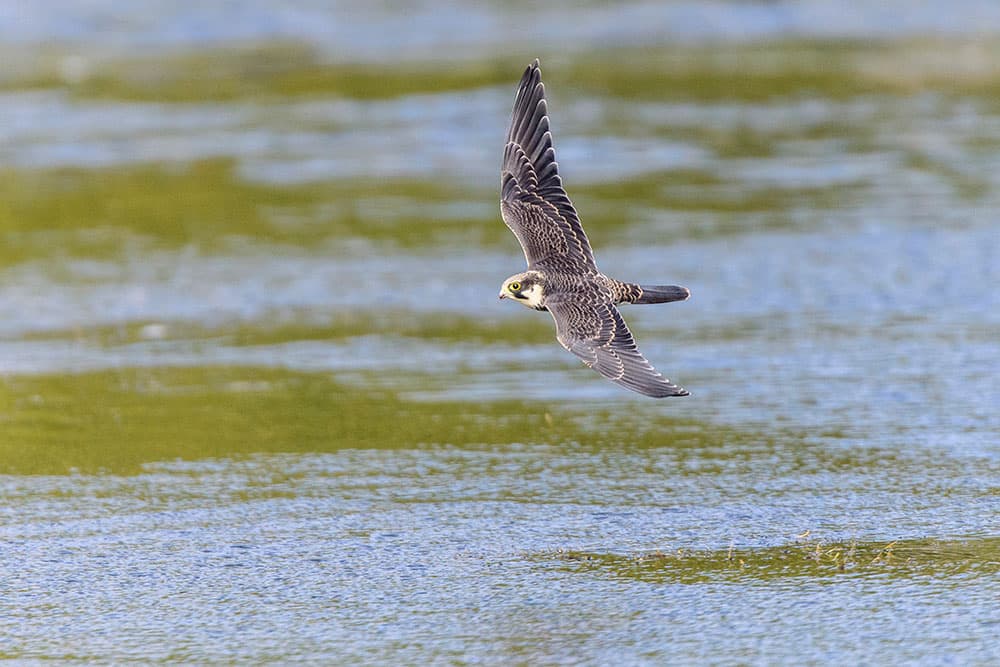About the hobbies
Hobbies resemble a giant swift, with their long, pointed wings and rapid, agile flight. This makes them a challenge to capture in sharp focus.
- Location Hobbies breed across most of England and Wales, excluding the more northern areas.
- Size Length 28-36cm, wingspan 70-92cm.
- Nest Nests almost always in trees (often pines); uses unoccupied corvid or raptor nests or grey squirrel dreys.
- Diet Mainly flying insects such as dragonflies and moths, and small birds, particularly fledglings of species such as swallows and martins.
- Population 2,800 UK breeding pairs.

Hobby diving to catch dragonflies. Nikon D800, 600mm, 1/2500sec at f/5.6, ISO 1000. Credit: Oscar Dewhurst
Hobbies are elegant birds of prey, with slate-grey upper parts, heavy black streaking on buff underparts and chestnut-coloured thighs and vent. The crown is the same colour as the upper parts, and on the face, a dark ‘moustache’ contrasts with pale cheeks and throat, and yellow facial skin. Roughly the same size as a kestrel, the long, pointed wings give the impression of a giant swift. They are extremely quick, which allows them to hunt prey such as dragonflies and birds like swallows and martins in mid-flight, which are often consumed on the wing. You can see them in this country from April, when they arrive in the UK from Africa, until October, when they return. Breeding is late, between the end of May and August, which coincides with an abundance of dragonflies and fledgling birds with which to feed the young.
They occupy relatively open areas with some trees, such as pastures, cultivation or scrub with scattered trees or copses, and are often seen near rivers and wetlands, where their prey can be found. Late summer and early autumn is a good time to photograph them as the young birds are learning to hunt for themselves. The abundance of prey such as dragonflies and young swallows and martins around wetland areas means these are often good places to look, and birds will often hunt for sustained periods, circling at height before diving downwards in pursuit of their target prey.
Note that hobbies are a Schedule 1 species, so if photographing them during the breeding season, extreme care must be taken to ensure you are not causing disturbance.

A fast frame rate is essential for capturing quick movements Nikon D800, 600mm, 1/1600sec at f/6.3, ISO 1000. Credit: Oscar Dewhurst
Shooting advice
Hobbies will often use the same perches to scan for prey. For the best chances, find where the birds hunt, as this may give you repeated opportunities to photograph them – I say repeated opportunities, as you are likely to need them, given how quickly the birds y and how agile they are in the air. Have a look at bird sightings pages for your area. I’ve had success photographing hobbies hunting dragonflies, as they will often come very low over the water in a (relatively) straight line, giving you a better chance to track them.
Photographing hobbies requires shutter speeds of at least 1/1000sec. Increase your ISO accordingly, as a sharp noisy photo is usually better than a clean blurry one. Continuous autofocus is essential, as is your fastest frame rate, particularly if you are hoping to capture them with talons outstretched as they move in for the kill. I use single spot autofocus, as this gives me the best success rate of having the focus where I want it. If the background is clear and distant (e.g. the sky), using more points can be beneficial. If the light is changing I tend to use aperture priority or manual mode if it’s constant. Take an exposure reading off a neutral colour, and check how it looks on the LCD screen, before dialling it in.

Hobbies come very low over the water for dragonflies. Nikon D800, 600mm, 1/4000sec at f/4, ISO 1250. Credit: Oscar Dewhurst
Kit list
- Tripod and gimbal head Hobbies fly extremely quickly, so a stable tripod and gimbal head make following them in flight easier and reduces movement that would result in losing focus on the bird.
- Binoculars I always carry my Swarovski binoculars with me whenever I’m out photographing, as they are invaluable for finding my subject, as well as for watching other wildlife I might see.








